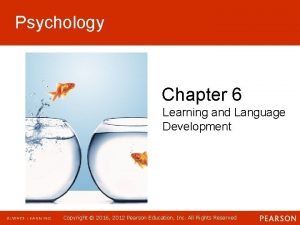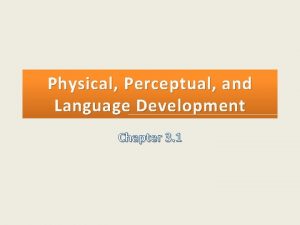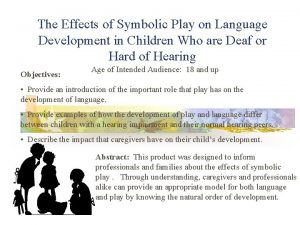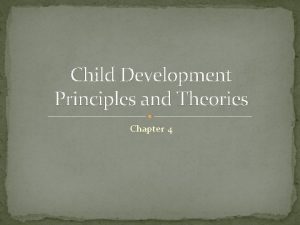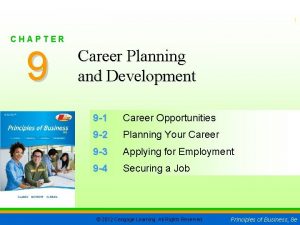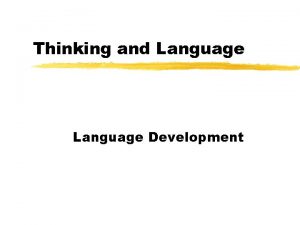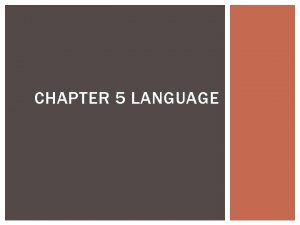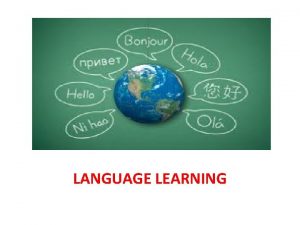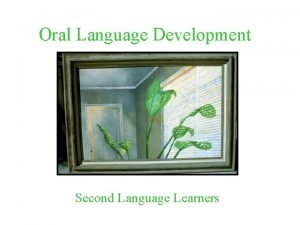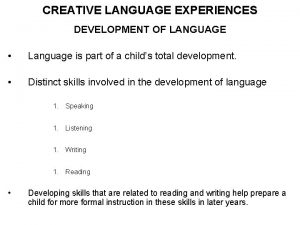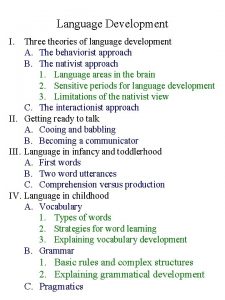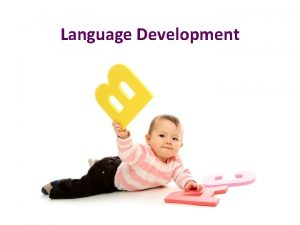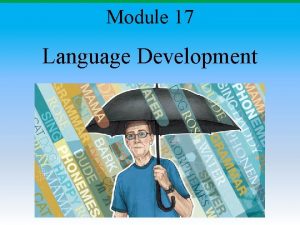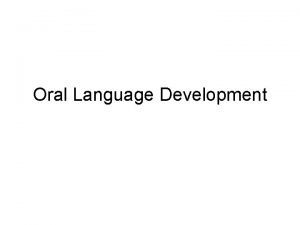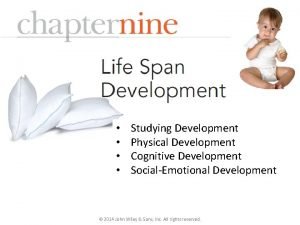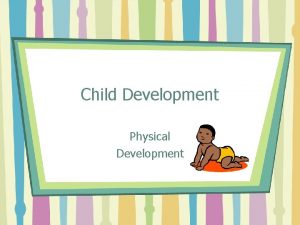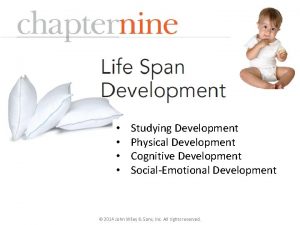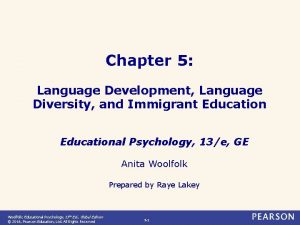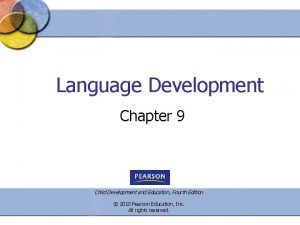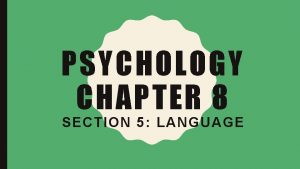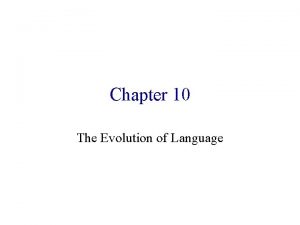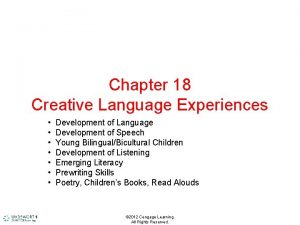The Development of Language Chapter 9 Language and























































- Slides: 55

The Development of Language Chapter 9 Language and Communication

How do we develop the ability to communicate? Module Objectives: What are the elements of speech? How do children develop speech? How do children learn the meaning of words?

Infants begin making sounds at birth. They cry, coo, and laugh…but in the first year they don’t really do much talking It could be argued that infants DO communicate with others, but do not have language

What is Language? Think about your language…maybe you even speak more than one! What makes a language? This is a broad concept…language is a system that relates sounds or gestures to meaning. ‐ Language is expressed through speech, writing and gesture.

There are four distinct elements to language -Phonology refers to the sounds of a language ‐ Semantics is the study of words and their meaning ‐ Grammar refers to the rules used to describe the structure of a language ‐Which involves syntax or rules that specify how words are combined to form sentences ‐ Pragmatics is the study of how people use language to communicate effectively

Children must learn to hear the differences in speech sounds and how to produce them; they must learn the meaning of words and rules for combining them into sentences and they must learn effective ways to talk with others

Phonemes The basic building blocks of language ‐ The unique sounds that can be joined to create words ‐ The sound of “p” in pin, pet, and pat ‐ The sound of “b” in bed, bat, and bird Infants can distinguish many of these sounds, some of them as early as 1 month after birth ‐ Can discriminate sounds they have never heard before such as phonemes from a foreign language

The language environment for infants is not solely auditory. Much language exposure comes from face-to-face interaction with adults

Infants use many tools to identity words in speech. They don’t understand the meaning of the word yet, but they can recognize a word as a distinct configuration of sounds

Parents and adults help infants master language sounds by talking in a distinctive style Think on your own… In what distinctive way do adults talk to infants? How can this help infants master the language?

Language development Infants are equipped for language even before birth, partly due to brain readiness, partly because of auditory experiences in the uterus ‐ Children around the world have the same sequence of early language development Newborns prefer to hear speech over other sounds- they prefer to listen to “baby talk”- the high pitched, simplified and repetitive was adults speak to infants The sound of a human voice, whether familiar or strange always fascinates infants

Adults Use Infant-Directed Speech Adults speak slowly and with exaggerated changes in pitch and loudness and elongated pauses between utterances ‐Also known as parentese, motherese, or child-directed speech Infant-direct speech may attract infants’ attention more than adult-directed speech because its slower pace and accentuated changes provide the infant with more salient language cues ‐ Helps infants perceive the sounds that are fundamental to their language

When talking to girls, adults use more words like “doggie” and “blankie” whereas with boys, adults use more words like “dog” and “blanket”. Girls hear twice as many diminutives.

If infant-directed speech helps infants perceive sounds that are essential to the development of their language… What about children who cannot hear?

Deaf Children About 1 in every 1, 000 American infants is born deaf ‐ Over 90% of deaf children have hearing parents ‐ These children are often delayed in language and complex make-believe play Mommy Daddy Baby

Deaf infants and toddlers seem to master sign language in much the same way and at about the same pace that hearing children master spoken language. ‐ Deaf 10 -month-olds often “babble” in signs: they produce signs that are meaningless but resemble the tempo and duration of real signs

Deaf Children Compared to hearing children, babbling of deaf children is delayed ‐ However, if they are exposed to sign language development will be right on schedule with normalhearing children’s speech development Hearing “dog”, infants in the middle of the first year of life may first say “dod” then “gog” before finally saying “dog” correctly ‐ The same gradual progression will occur with sign language – infants will make mistakes at first before making the correct sign for dog

Speech Production At 2 months, infants begin making sounds that are language-based ‐Starts with cooing They begin by producing vowel-like sounds, such as “ooooo” and “ahhhh” At 5 to 6 months, infants begin making speech-like sound that have no meaning ‐Cooing turns into babbling

“Baby Talk” Babbling is the extended repetition of certain single syllables, such as “ma-ma -ma, da-da-da, ba-ba-ba” that begins at 6 -7 months of age. Babbling is experience-expectant learning ‐All babies babble ‐All babies gesture ‐The sounds they make are similar no matter what language their parents

“Babbling” Over the next few months, babbling incorporates sounds from their native language. Even untrained listeners can distinguish between babbling infants who have been raised in cultures in which French, Arabic, or Cantonese languages were spoken. ‐ Many cultures assign important meanings to the sounds babies babble: ‐ “ma-ma-ma”, “da-da-da” and “pa-pa-pa” are usually taken to apply to significant people in the infant’s life

First Words Infants first recognize words, then they begin to comprehend words At about 4 ½ months of age, infants will listen longer to a tape repeating their own name than to a tape of different but similar name At about 7 -8 months of age, infants readily learn to recognize new words and remember them for weeks

At 6 months – if an infant hears either “mommy” or “daddy”, they look toward the appropriate person.

st 1 By their birthday, infants usually say their first words, usually an extension of babbling. By the age of 2 most children have a vocabulary of a few hundred words, and by age 6 the vocabulary includes over 10, 000 words!

The Importance of Symbols Children begin using gestures, which are symbols shortly before their first birthday. Gestures and words convey a message equally well…sometimes gestures pave the way for language ‐ In one study, 50% of all objects were referred to first by gesture and, about 3 months later, by word (Iverson & Meadow, 2005)

After children know that objects have names, a gesture is a convenient substitute for pronouns like “it” or “that” and often cause the adult to say the object’s name

Names for everything! Once an infant’s vocabulary reaches about 50 words it suddenly begins to build rapidly, at a rate of 50 -100+ words per month, mostly nouns. This language spurt occurs around 18 months and is sometimes called the Naming explosion.

Productive Vocabulary Early productive vocabularies of children in the US include names for people, objects, and events from the child’s everyday life. ‐Frequent events or routines are also labeled, such as “up” or “byebye” ‐Nouns predominate the early productive vocabularies of children

The rate of children’s vocabulary development is influenced by the amount of talk they are exposed to The more speech that is addressed to a toddler, the more rapidly the toddler will learn new words

Word Comprehension Fast Mapping is the process of rapidly learning a new word simply from the contrastive use of a familiar word an unfamiliar word The children’s ability to connect new words to familiar words so rapidly that they cannot be considering all possible meaning for the new word

Example of Fast Mapping In a preschool classroom, an experimenter drew a child’s attention to two blocks – asking the child to “get the celadon block not the blue one” From this simple contrast, the child inferred that the name of the color of the requested object was “celadon” After a single exposure to this novel word, about half the children showed some knowledge of it a week later by correctly picking the celadon color child from a bunch of paint chips

Give Fast-Mapping a try… Answer the following questions on you own.

1. 2. 3. 4. 5. This is a snurk. It walks on its flaxes. How many flaxes does a snurk have? Snurks have twice as many flaxes as ampolinks. Where are the amopolinlks? Snurks are covered with garslim. Garslim is like _____? Like dogs, snurks can wag their pangeers. Where is the pangeer? Do you think snurks can bispooche? Why or why not?

These questions put you back in toddlers shoes listening to adults speak. Like toddlers, you all must rely on context to comprehend the strange vocabulary to describe the snurk. In absence of adequate context, comprehension is impossible (as you experienced in question #5).

Early Errors in Language One common inaccuracy is underextension –using a word too narrowly. ‐Using the word “cat” to refer only to the family cat ‐Using the word “ball” to refer only to a favorite toy ball

Sarah refers to the blanket she sleeps with as “blankie”. When Aunt Ethel gives her a new blanket Sarah refuses to call the new one a “blankie” – she restricts that word only to her original blanket.

Overextension The use a given word in a broader context than is appropriate ‐ Common between 1 and 3 years of age ‐ More common than Underextension Toddlers will apply the new word to a group of similar experiences ‐ “Open” – for opening a door, peeling fruit, or undoing shoelaces

Language Errors Children overextend because they have not acquired another suitable word or because they have difficulty remembering a more suitable word Examples: ‐ Ball referring to ball, balloon, marble, egg, or apple ‐ Moon referring to moon, half-moon shaped lemon slice, or half a Cheerio ‐ Car referring to a car, bus, truck, or tractor ‐ Daddy referring to dad or any man ‐ Doggie referring to dog or any four-legged animal

Making Sentences Most children begin to combine words into simple sentences by 18 to 24 months of age Children’s first sentences are two-word combinations referred to as Telegraphic speech ‐ Words directly relevant to meaning Words not critical to the meaning are left out – similar to the way telegrams were written such as: ‐ Function words: a, the in ‐ Auxiliary words: is, was, will be ‐ Word endings: plurals, possessives, verb tenses

These sentences are brief and to the point, containing only vital information “More cookie”, “Mommy go”, “Daddy juice”, “Sue dogs”

By about 2 ½ years of age, children have the ability to produce more complex sentences (four or more words per sentence). The longer sentences are filled with grammatical morphemes (words or endings of words that make sentences more grammatical). A 1 ½-year-old might say “kick ball” but a 3 -year-old would be more likely to say “I am kicking the ball”

Overregularization Speech errors in which children treat irregular forms of words as if they were regular. ‐ Applying rules to words that are exceptions to the rule ‐ This leads young children to talk about foots, tooths, sleeps, sheeps and mouses. Although technically wrong, Overregularization is a sign of verbal sophistication because it shows children are applying the rules to grammar.

Between 3 and 6 Years of Age Children learn to use negation ‐ “That isn’t a butterfly” Children learn to use embedded sentences ‐ “Jennifer thinks that Bill took the book” Children begin to comprehend passive voice as opposed to active voice ‐ “The ball was kicked by the girl” as opposed to “The girl kicked the ball” By the time most children enter kindergarten, they use most of the grammatical forms of their native language

The development of language in children is amazing, but how do they do it? There are several theories that attempt to explain how we develop language

Infants Are Conditioned to Speak Behaviorist’s believe that all learning is acquired step-by-step, through associations and reinforcements According to this view, the reinforcement of the quantity and quality of talking to child affect rate of language development. When a 6 month-old says, “ma-ma-ma” they are showered with attention and praise. This is exactly what the baby wants and will make the sounds again to get the same rewards.

Say Ma-Ma…. . Children who are spoken to more and praised by caregivers tend to develop language faster. Parents are great intuitive teachers- we name items for infants and praise infants when they repeat our words. For instance, parents typically name each object when they talk to their child, “Here is your bottle”, “There is your foot”, “You want your juice? ” Parents name the object and speak clearly and slowly, often using baby talk to capture the infant’s interest (Gogate et al. , 2000).


What Do the Linguist’s say? Noam Chomsky believes language is a product of biology and is too complex to be mastered so early and easily by conditioning. Chomsky noted that children worldwide learn the rudiments of grammar at approximately the same age because the human brain is equipped with a language device. ‐ including intonations and structure of language

Our Brain is Specialized for Language LAD (language acquisition device) is an area of our brain which facilitates the development of language. Chomsky believes that the LAD facilitates language and enables children to derive the rules of grammar from everyday speech, regardless of the native language. Language is experience-expectant, words are expected by the developing brain-Chomsky believes that children are pre-wired for language

Think about a successful conversation What factors influence effective communication?

Using Language to Communicate For effective oral communication: ‐ People should take turns, alternating as speaker and listener ‐A speaker’s remarks should relate to the topic and be understandable to the listener ‐A listener should play attention and let the speaker know if his or her remarks do not make sense

Taking Turns Soon after 1 -year-olds begin to speak, parents encourage their children to participate in conversational turn-taking By age 2, spontaneous turn-taking is common in conversations between children and adults By age 3, children have progressed to the point that if a listener fails to reply promptly, the child repeats his or her remark in order to elicit a response

Taking Turns Parent: Can you see the bird? Infant (cooing): oooooh Parent: It is a pretty bird. Infant: oooooh Parent: You’re right, it’s a cardinal. Parents having a conversation with a 6 week-old infant still involve taking turns. To help children along, parents often carry both sides of the conversation to demonstrate how the roles of speaker and listener alternate.

Initiating a Conversation The first attempt to deliberately communicate typically emerges at 10 months ‐ Usually by touching or pointing to an object while simultaneously looking at another person At 1 year, infants begin to use speech to communicate and often initiate conversations with adults ‐ First conversation are about themselves but this rapidly expands to include objects in their world By preschool, children begin to adult their messages to match the listener and the context ‐ School-age children speak differently to adults and peers ‐ Preschool children give more elaborate messages to listeners who are unfamiliar with a topic than to listeners who are familiar with it

Click on the picture for an interesting article on language development

What’s Next? How Do Our Emotions Develop?
 Chapter 6 learning and language development
Chapter 6 learning and language development Chapter 6 learning and language development
Chapter 6 learning and language development Hình ảnh bộ gõ cơ thể búng tay
Hình ảnh bộ gõ cơ thể búng tay Lp html
Lp html Bổ thể
Bổ thể Tỉ lệ cơ thể trẻ em
Tỉ lệ cơ thể trẻ em Voi kéo gỗ như thế nào
Voi kéo gỗ như thế nào Tư thế worm breton
Tư thế worm breton Alleluia hat len nguoi oi
Alleluia hat len nguoi oi Môn thể thao bắt đầu bằng từ chạy
Môn thể thao bắt đầu bằng từ chạy Thế nào là hệ số cao nhất
Thế nào là hệ số cao nhất Các châu lục và đại dương trên thế giới
Các châu lục và đại dương trên thế giới Công của trọng lực
Công của trọng lực Trời xanh đây là của chúng ta thể thơ
Trời xanh đây là của chúng ta thể thơ Mật thư anh em như thể tay chân
Mật thư anh em như thể tay chân 101012 bằng
101012 bằng độ dài liên kết
độ dài liên kết Các châu lục và đại dương trên thế giới
Các châu lục và đại dương trên thế giới Thể thơ truyền thống
Thể thơ truyền thống Quá trình desamine hóa có thể tạo ra
Quá trình desamine hóa có thể tạo ra Một số thể thơ truyền thống
Một số thể thơ truyền thống Bàn tay mà dây bẩn
Bàn tay mà dây bẩn Vẽ hình chiếu vuông góc của vật thể sau
Vẽ hình chiếu vuông góc của vật thể sau Nguyên nhân của sự mỏi cơ sinh 8
Nguyên nhân của sự mỏi cơ sinh 8 đặc điểm cơ thể của người tối cổ
đặc điểm cơ thể của người tối cổ Giọng cùng tên là
Giọng cùng tên là Vẽ hình chiếu đứng bằng cạnh của vật thể
Vẽ hình chiếu đứng bằng cạnh của vật thể Vẽ hình chiếu vuông góc của vật thể sau
Vẽ hình chiếu vuông góc của vật thể sau Thẻ vin
Thẻ vin đại từ thay thế
đại từ thay thế điện thế nghỉ
điện thế nghỉ Tư thế ngồi viết
Tư thế ngồi viết Diễn thế sinh thái là
Diễn thế sinh thái là Dot
Dot Số nguyên tố là số gì
Số nguyên tố là số gì Tư thế ngồi viết
Tư thế ngồi viết Lời thề hippocrates
Lời thề hippocrates Thiếu nhi thế giới liên hoan
Thiếu nhi thế giới liên hoan ưu thế lai là gì
ưu thế lai là gì Hổ sinh sản vào mùa nào
Hổ sinh sản vào mùa nào Sự nuôi và dạy con của hổ
Sự nuôi và dạy con của hổ Sơ đồ cơ thể người
Sơ đồ cơ thể người Từ ngữ thể hiện lòng nhân hậu
Từ ngữ thể hiện lòng nhân hậu Thế nào là mạng điện lắp đặt kiểu nổi
Thế nào là mạng điện lắp đặt kiểu nổi Chapter 5 diversity and human needs and development
Chapter 5 diversity and human needs and development What is the history of community development?
What is the history of community development? Development that ended much development crossword
Development that ended much development crossword Where does the radial line development commonly used
Where does the radial line development commonly used Physical perceptual and language development
Physical perceptual and language development Symbolic play and language development
Symbolic play and language development Internally programmed growth of a child
Internally programmed growth of a child Child development principles
Child development principles Chapter 9 agricultural transformation and rural development
Chapter 9 agricultural transformation and rural development Chapter 9 agricultural transformation and rural development
Chapter 9 agricultural transformation and rural development Chapter 9 career planning and development
Chapter 9 career planning and development Human needs and human development
Human needs and human development

